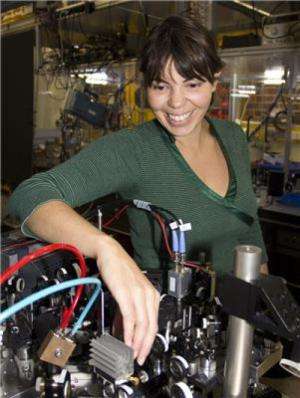Physicists provide new insights into the world of quantum materials

In Innsbruck, Austria, a team of physicists led by Francesca Ferlaino experimentally observed how the anisotropic properties of particles deform the Fermi surface in a quantum gas. The work published in Science provides the basis for future studies on how the geometry of particle interactions may influence the properties of a quantum system.
How a system behaves is determined by its interaction properties. An important concept in condensed matter physics for describing the energy distribution of electrons in solids is the Fermi surface, named for Italian physicist Enrico Fermi. The existence of the Fermi surface is a direct consequence of the Pauli exclusion principle, which forbids two identical fermions from occupying the same quantum state simultaneously. Energetically, the Fermi surface divides filled energy levels from the empty ones. For electrons and other fermionic particles with isotropic interactions – identical properties in all directions - the Fermi surface is spherical.
"This is the normal case in nature and the basis for many physical phenomena," says Francesca Ferlaino from the Institute for Experimental Physics at the University of Innsbruck. "When the particle interaction is anisotropic – meaning directionally dependent – the physical behavior of a system is completely altered. Introducing anisotropic interactions can deform the Fermi surface and it is predicted to assume an ellipsoidal shape."
The deformation of the Fermi surface is caused by the interplay between strong magnetic interaction and the Pauli exclusion principle. Francesca Ferlaino and her experimental research group have now been able to show such a deformation for the first time.
Simulation in ultracold quantum gas
For their experiment, the quantum physicists confined a gas of fermionic erbium atoms in a laser trap and cooled it to almost absolute zero. The element erbium is strongly magnetic, which causes extreme dipolar behavior. The interaction between these atoms is, therefore, directionally dependent. When the physicists release the ultracold gas from the trap, they are able to infer the shape of the Fermi surface from the momentum distribution of the particles. "Erbium atoms behave similarly to magnets, which means that their interaction is strongly dependent on the direction in which the particles interact. Our experiment shows that the shape of the Fermi surface depends on the geometry of the interaction and is not spherical anymore," explains first author of the study Kiyotaka Aikawa the phenomenon that is extremely difficult to observe.
Basic question
"The general question we deal with here is how the geometry of particle interactions influences the quantum properties of matter," explains Francesca Ferlaino. Answering this question is of interest for physicists from different branches of physics such as the study of high-temperature superconductors. "We need a better understanding of these properties to develop new quantum systems," underlines Francesca Ferlaino. Ultracold quantum gases once more provide an ideal platform for simulating complex scenarios.
More information: Observation of Fermi surface deformation in a dipolar quantum gas, Science 19 September 2014: Vol. 345 no. 6203 pp. 1484-1487 DOI: 10.1126/science.1255259
Journal information: Science
Provided by University of Innsbruck




















